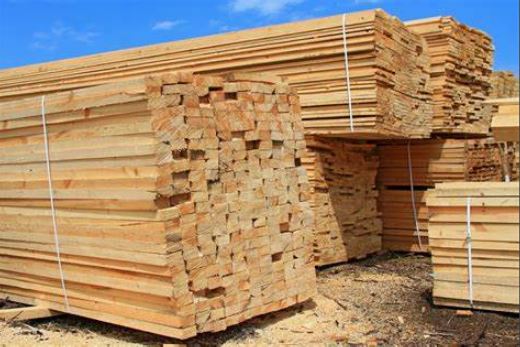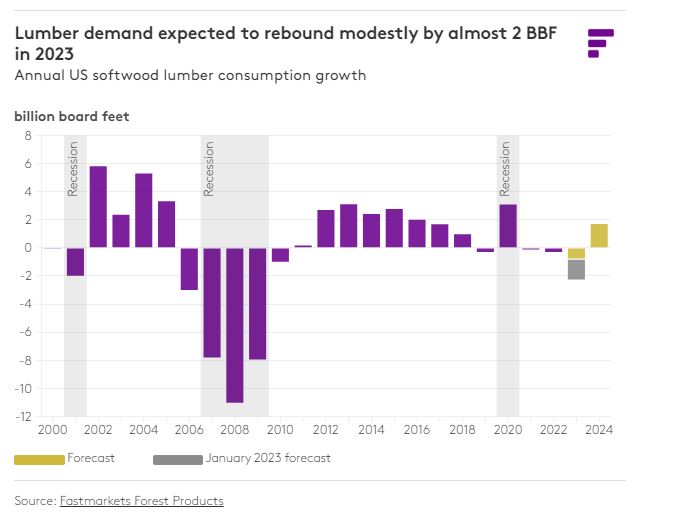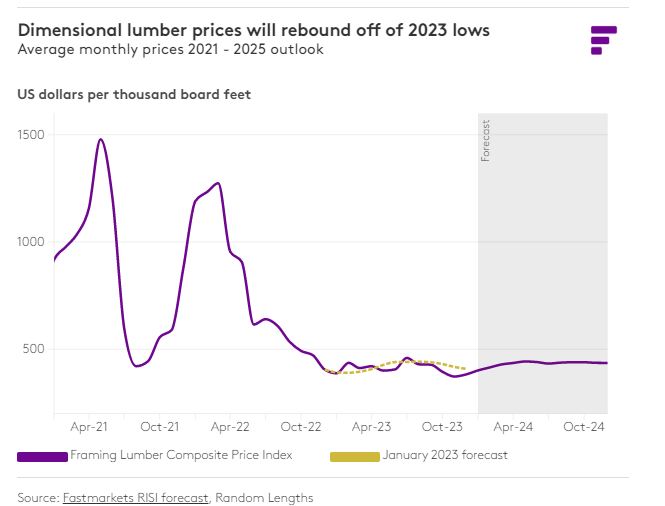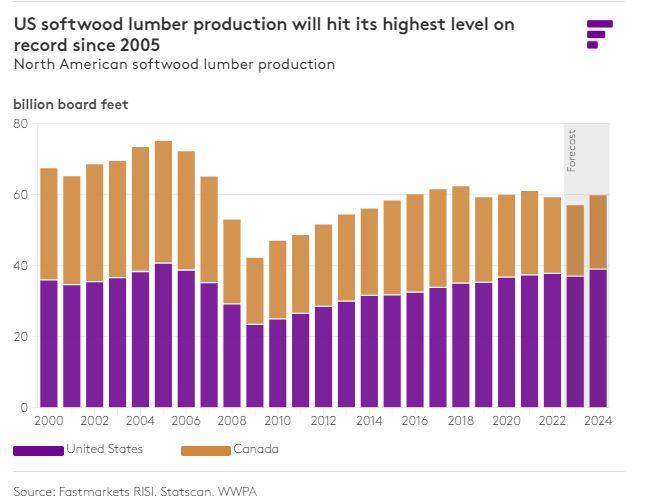
How could softwood lumber prices be affected by
developments in the US residential construction market in 2024?
In this deep dive outlook, Fastmarkets¡¯ senior economist Dustin
Jalbert outlines his predictions for the year ahead
Another year is behind us, with no shortage of discussion topics
when reflecting on the US residential construction and wood
products markets in 2023. In many ways, the year played out how
our team expected as we laid out in last year¡¯s ¡°Predictions¡±
piece.
Here is how our predictions played out throughout 2023:
-
Housing and lumber demand took a significant hit
-
Lumber prices scraped along the top of the cash cost curve
around $400 per thousand board feet (MBF)
-
About 1.3 billion board feet (BBF) of closures were
announced for British Columbia
-
And inflation is now rapidly cooling toward the Federal
Reserve¡¯s target.
But things have played out in unexpected ways as well. For one,
the single-family market rebounded more rapidly than anticipated
in the second half of the year. The US labor market also
remained far more resilient to the Fed¡¯s salvo of rate hikes and
the winddown of fiscal stimulus than most forecasts ¨C including
our team ¨C were calling for.
By popular demand, we¡¯ve decided to follow up on last year¡¯s
¡°Predictions¡± piece with another for 2024. As we frequently
remind our readers, the future is uncertain and market
conditions can change rapidly. Nevertheless, here are
Fastmarkets¡¯ key calls for the 2024 housing and lumber market.
Prediction 1: Unemployment will remain historically low in
2024 as the US economy dodges a recession
Prediction 2: Single-family housing starts will grow by over
1 million units in 2024
Prediction 3: Repair and remodeling volumes will continue to
flatline through 2024
Prediction 4: Lumber consumption will grow by 1.7 BBF in 2024
As we stated last year, it¡¯s no surprise that our view of the
housing market largely dictates the demand outlook for lumber
and other wood products. New residential construction and R&R
combined account for roughly 70-80% of US wood products demand.
For full transparency, readers will be reminded that our call
for lumber consumption last year was for a drop of about 2.2 BBF.
We still have several months of industry data to be delivered
before we can fully evaluate 2023 demand levels, but compared
with our January 2023 forecast, consumption will likely have
surprised to the upside by more than 1 BBF. This is largely due
to the much more aggressive incentive measures taken by builders
that we mentioned earlier, which helped soften the blow in
consumption for the year.
From a volume perspective, a year slated for solid growth in
single-family housing and flattish R&R demand suggests a
volume-positive year for most wood product categories. Even with
the further declines in multifamily that we are calling for in
Prediction 2, it¡¯s important to remember that single-family
homes use roughly three times more lumber per start than a
typical multifamily start ¡ª due to more floor space, a higher
share of stick framed, etc. Single-family starts are also
currently about double those of multifamily. There are other
considerations also, such as shrinking home sizes and material
substitutions, but even accounting for these factors, the arrow
points up on softwood lumber demand in 2024.

Fastmarkets¡¯ call for US softwood lumber consumption to advance
by 1.7 BBF (3.4%) is by no means a gangbuster year of growth. In
fact, it is very much in line with typical volume gains for the
industry over the last decade or so. However, consumption
reversing course after falling about 0.8 BBF (1.6%) in 2023
based on our latest estimates will be a welcome change for
building material dealers, wholesalers and mills alike.
Prediction 5: Lumber prices will bottom in 2023, setting up
for modest appreciation into 2024
As we emphasized in last year¡¯s ¡°Predictions¡± piece and in our
recent editions of the Lumber Commentary, there¡¯s reason to
believe month-to-month price volatility will remain elevated
compared with the sleepy days prior to 2018.
However, market participants will need to accept that the
volatility in the market witnessed from the spring of 2020 and
through 2022 is behind us now. This was a black swan event,
largely stemming from both demand and supply shocks directly
tied to the pandemic that are now subsiding. Mill staffing and
production has now recovered fully, the surge in demand from the
R&R and single-family boom have corrected, and transportation
and distribution are facing a fraction of the disruptions we saw
in 2021 and 2022. We are now in a normal demand-supply
equilibrium, which suggests the price-surge environment we saw
for two years is over. This correction was clear in 2023, when
the Random Lengths Framing Lumber Composite Price (FLCP)
averaged $411 per MBF for the year, which we will proudly note
was within $8 per MBF of our January 2023 forecast.

So, what is the good news for mill operators and traders in
2024? The demand rebound we anticipate in 2024 sets the industry
up for tightening operating rates, which should carry prices
higher. While supply continues to expand as southern yellow pine
(SYP) capacity ramps up in the US South, closures and
constrained log supply in the rest of North America will keep
capacity gains modest, trending at a modest 1-2% in most years.
This should provide the opportunity for demand growth to
overshoot supply growth in 2024.
We predict Western SPF 2&Btr 2¡Á4 will average $427 per MBF in
2024 and the FLCP will average $432 per MBF, which translates to
mid- to high-single-digit growth in prices year over year.
Prices at current levels are also not sustainable for a
significant swath of the North American industry, namely
dimensional lumber producers in British Columbia who are coping
with variables breakeven levels in the low $400s per MBF for
lumber delivered to the US (and notably still facing antidumping
and countervailing duties). The salvo of closures we predicted
and saw in 2023 reflects the challenging market environment for
high-cost mills in North America.
As lumber prices gain upward momentum, temporarily curtailed
sawmill capacity will come in from the sidelines. This will keep
supply and demand in balance and temper the magnitude of the
price increases. Competing sources of supply from offshore,
particularly from Central and Northern Europe, which has gained
share over the years, will also keep the market in check. While
the year-over-year gains in dimension lumber prices will be
modest, a year of net price appreciation will still be a welcome
development for much of the wood products supply chain.
Prediction 6: US softwood lumber production will hit its
highest level since 2005
Finally, what about the supply side of the lumber market? After
a year of significant capacity rationalization, what should we
expect in 2024? Our key prediction is that US sawmill production
will hit its highest level since peaking in 2005, marking the
second-highest level on record.
While 2023 was a challenging environment for mill operators,
many sawmills in the US have been able to limp along through
this market as Canadian operators took the brunt of the pain,
with many of them cash-negative at prevailing dimensional lumber
prices. This also explains the wave of Canadian closures we
predicted and ultimately saw in 2023. SYP production, which
accounts for about 38% of North American softwood lumber output,
also has the added tailwind of very low delivered fiber costs.
Most producers in the US South with modern, state-of-the-art
sawmill operations are still cash-positive. We¡¯ve also seen SYP
capacity investment trending close to 1 BBF a year in recent
years, which in most years was more than sufficient to counter
capacity losses, particularly those in British Columbia.
The growing US share of the North American lumber market has
been a secular trend driven ultimately by lower fiber costs in
the rapidly growing US South but also accelerated by duties and
managed trade for Canadian sawmills as well as the long-term
consequences of the mountain pine beetle kill in British
Columbia. This is a noteworthy development considering that
historically, Canada has accounted for anywhere between a
quarter to a third of US softwood lumber consumption.

The story of secular decline in BC production tends to dominate
the narrative in the lumber industry, but the rise of the US
lumber industry after a decade of pain stemming from the capital
destruction brought on by the housing crash in 2008-10 remains
an important part of the supply story. For commodities like
lumber, the low-cost supplier tends to prevail over the long
run. We are seeing this happen in real-time as SYP continues to
fill the supply void, just as home construction and lumber
demand is primed for a recovery in demand in 2024.
Want to learn more about the lumber market, prices, or
forecasts? Check out our dedicated
page for timber/lumber,
other wood
products,
or speak
to our team about
accessing our news, analysis, forecasts and more.
Source:
fastmarkets.com
